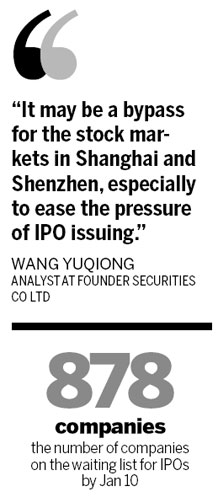SMEs gain greater access to funds
Updated: 2013-01-17 07:28
By Chen Jia (China Daily)
|
||||||||
'Third board' to satisfy growing financing needs for non-listed firms
China's equity transfer system for non-listed small and medium-sized enterprises was introduced in Beijing on Wednesday, opening up a national over-the-counter and off-exchange market to satisfy growing financing demand, the China Securities Regulatory Commission said.
The step is a milestone for the Chinese capital market. A unified platform will take the place of the previous regional pilot programs for equity trading in small companies that have not yet reached the conditions needed for listing.
After the launch, the shares of the companies in the four pilot zones - including Shanghai and Tianjin - will be traded in Beijing.
Guo Shuqing, the chairman of the CSRC, said on Wednesday that the current proportion of companies that directly raise money from the equity market is "too small".
So far, there are about 1,400 companies listed in Shanghai and 1,050 in Shenzhen, only 0.02 percent of the total number of Chinese State-owned and private companies.
At the end of 2012, the Shanghai benchmark stock index increased 3.17 percent year-on-year, and the value of the mainland stock market surpassed Japan to become the second-largest in the world, according to Guo.
More measures are in store to promote the multi-level capital market, Guo said.

The CSRC has not yet released a detailed transaction regulation for the new national OTC market, or the so-called third board. The new platform has a lower threshold for companies to enter the market compared with other platforms.
The CSRC has also improved a series of measures in 2012 to regulate non-listed companies, including information exposure and capital requirements.
"The development route of the OTC market will be designed based on market demand," Yao Gang, vice-chairman of the CSRC, said on Wednesday.
The new market will not be isolated from the main board in Shanghai and the ChiNext, or the Chinese Nasdaq-style market, in Shenzhen, and it will help companies prepare for going public when they reach a stage of fast growth, analysts said.
It will be important to balance trading on stock exchanges and off-exchange trading to achieve stable operations and shore up emerging businesses, Yao said.
The new board will be an important part of China's financial sector, said Wang Yuqiong, an analyst with Founder Securities Co Ltd.
"It will be a foundation for the capital market, although it is now in its infancy," Wang said. "It may be a bypass for the stock markets in Shanghai and Shenzhen, especially to ease the pressure of IPO issuing."
According to the CSRC, there were 878 companies on the waiting list for IPOs by Jan 10.
Mainland stocks fell on Wednesday. The Shanghai Composite Index retreated 0.7 percent to close at 2309.50 from its eight-month high of 2311.74, which was reached on Tuesday.
The CSI 300 Index, which entered a bull market earlier this month with a 20 percent gain from its December low, lost 0.7 percent to 2577.09.
China's first OTC market pilot program started in 2006 in Beijing's Zhongguancun, a high-tech industrial park, with about 100 non-public companies.
In August last year, the State Council, or China's cabinet, approved a plan to expand the pilot zones for the new OTC equity market.
Pilot areas were set up in the Zhangjiang High-tech Industrial Development Zone in Shanghai, the East Lake High-Tech Development Zone in Wuhan, and Tianjin's Binhai High-Tech Industrial Development Area.
By the end of December, 200 companies from the four pilot zones had listed equities on the regional OTC market, according to the CSRC.
Last year, the CSRC also encouraged direct financing for small companies through the use of high-return privately raised corporate bonds.
chenjia1@chinadaily.com.cn
(China Daily 01/17/2013 page16)

 In Photos: 7.0-magnitude quake hits Sichuan
In Photos: 7.0-magnitude quake hits Sichuan
 Li Na on Time cover, makes influential 100 list
Li Na on Time cover, makes influential 100 list
 FBI releases photos of 2 Boston bombings suspects
FBI releases photos of 2 Boston bombings suspects
 World's wackiest hairstyles
World's wackiest hairstyles
 Sandstorms strike Northwest China
Sandstorms strike Northwest China
 Never-seen photos of Madonna on display
Never-seen photos of Madonna on display
 H7N9 outbreak linked to waterfowl migration
H7N9 outbreak linked to waterfowl migration
 Dozens feared dead in Texas plant blast
Dozens feared dead in Texas plant blast
Most Viewed
Editor's Picks

|

|

|

|

|

|
Today's Top News
Live report: 7.0-magnitude quake hits Sichuan, heavy casualties feared
Boston suspect cornered on boat
Cross-talk artist helps to spread the word
'Green' awareness levels drop in Beijing
Palace Museum spruces up
First couple on Time's list of most influential
H7N9 flu transmission studied
Trading channels 'need to broaden'
US Weekly

|

|







